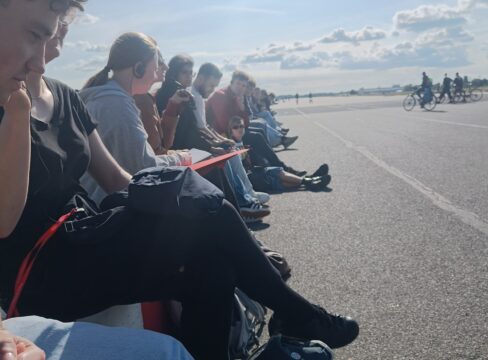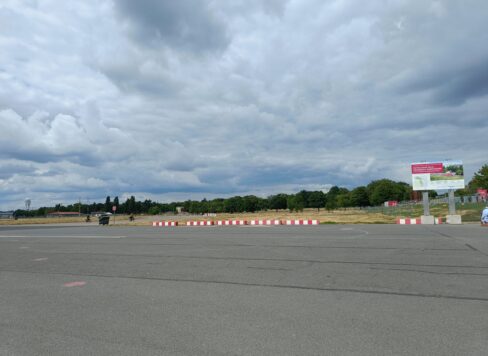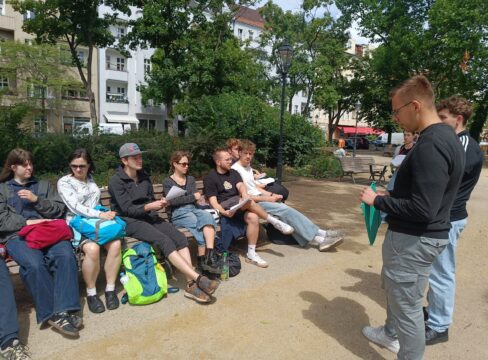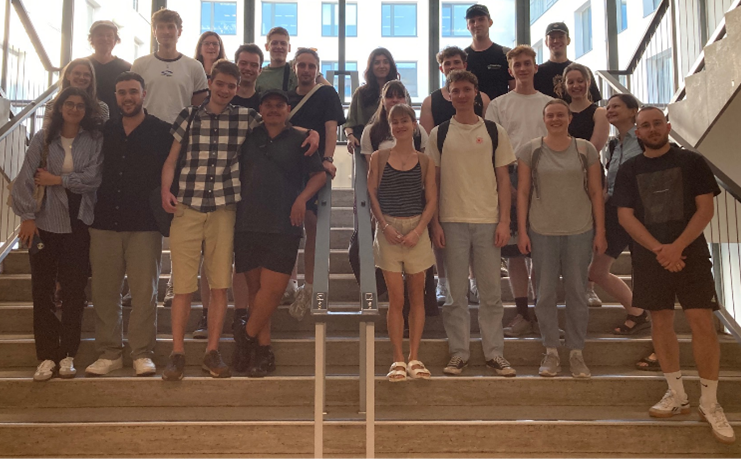Climate Change Adaptation and Democracy in Berlin
From July 7 to 12, the second part of the comparative excursion “Democracy and Climate Change Adaptation in Berlin and Vienna” of the Department of Geography and Regional Research of the University of Vienna took place in collaboration with the Department of the Humboldt University of Berlin (HU-B).
A review of Part 1 of the excursion and the objectives of the course can be found here:
This time, nine students from the University of Vienna, accompanied by Prof. Dr. Kerstin Krellenberg and Dr. Julia Wesely, traveled to Berlin and explored various projects and initiatives at the intersection of climate change adaptation and democracy in Berlin together with twelve students from HU-B and Prof. Dr. Henning Nuissl. The excursion team was also supported by Aileen Pohl, who documented and evaluated the excursion format.
The “Course Guide: Lessons Learned from a Circle U. Collaborative Field Trip” synthesizes the documentation and reflections for anyone interested in developing a similar comparative course.
The excursion built on the discussions in Vienna in relation to six thematic areas, each of which were developed into a half-day programme by student groups of HU-B:
- Scalar Dimensions (Livia Stümer, Nicolás Bech)
- Direct Democracy (Christoph Biagini, Oliver Wallers)
- Urban Social Movements (Natascha Lorenzen, Nele Schleehahn)
- Democracy and Climate-just Cities (Franz Spielmann, Paul Hoffmann)
- Tactical Urbanism (Jonas Vogler)
- Citizen Participation (Özkan Aydogan, Suude Naz Cayli)
Here you can read thematic reflections of the Viennese and Berlin students in the form of individual blog posts (only available in German).
The first day of the excursion week dealt with the topic of scalar dimensions. The selected examples demonstrate how diverse, politically charged and often contradictory climate adaptation is negotiated in urban areas. In projects such as the Flussbad Berlin, the climate-friendly redesign of the Gendarmenmarkt and the (discontinued) traffic calming measures of Friedrichstraße, visions of climate-resilient quality of life and adaptation collide with questions of monument protection, commercial interests and technical and financial feasibility. The common thread running through all of these projects is the lack of political continuity, which makes the planning process of many projects uncertain. The thematic programme ended with a visit to Hafenplatz in Kreuzberg, where discussions on social justice in the form of affordable housing and climate-resilient redevelopment plans come together. An expert discussion was held with a representative of the local citizens’ initiative. In the discussion about the course of the conflict, he emphasized: “Justice must work in all directions.”
On the second day, Tempelhofer Feld proved to be a good example of direct democracy. The large open space of the old airport site contributes to climate adaptation and is a popular local recreation area. However, the potential for creating residential areas is also being discussed here. This part of the excursion focused on two referendums, in which citizens spoke out against construction. In addition, there are currently plans to hold a new referendum on developing residential housing at the edge of the area. The students were asked to discuss the extent to which the implementation of these plans would restrict the character of the site. Through group walks around the area, they observed how the space is currently being used in different ways. In the joint final reflection, the question arose as to how much the impact of, and trust in, instruments of direct democracy can suffer if political decision-makers do not fully recognize their results.
The third day of the excursion started in Treptow-Köpenik and dealt with the topic of urban social movements, learning from the example of Fridays for Future (FFF). To begin with, the students went in small groups on a walking observation through the neighbourhood, observing the the (lack of) implementation of the FFF´s demands in this district with regard to climate adaptation. The student team then invited a representative from FFF to gain more insights into the movement’s internal structures, organization and challenges in terms of setting priorities. The students were then able to experience for themselves how difficult it is to implement demands for change with FFF’s limited resources. They were given the task of organizing a protest against the further expansion of the A100 motorway in Berlin. The exercise showed that even if individual perspectives allow for many creative ideas, financial and organizational constraints and challenges quickly reveal the potential for internal conflict and frustration.
On the morning of the fourth day of the excursion, the topic of democracy and climate-just cities was addressed, starting with a short visit to the House of Democracy and Human Rights. This place considers itself independent from (party) politics and provides space for the work of all civil and human rights movements. The student team then took the group to Haus der Statistik (translated “House of Statistics”), which is currently under construction. This area is to become a communal and cooperative place, bringing together public administration and citizens. It will provide space for housing, culture, education, and social activities. The excursion slot ended with a visit to the hidden and somewhat overgrown neighbourhood garden at Moritzplatz. In small groups, the students developed ideas on how the use of the garden could be further enhanced. However, they also observed other visitors during their stay and got the impression that the neighbourhood garden was already used by many people and in various ways. Hence, a discussion emerged about the necessity to intervene at all, and some argued that the city needs places such as this neighbourhood garden, which adapt flexibly to the needs of their users and change incrementally.
The afternoon of the fourth day of the excursion, focused on the topic of tactical urbanism and superblocks. After a brief reference back to the superblock idea and the example of the Supergrätzl presented in Vienna, the group conducted walking observations in two neighbourhoods of the Neukölln district. In the Schillerkiez, the students analyzed the narrow spatial layout, the problematic traffic routes despite already designated bicycle lanes, and the almost non-existent consumption-free space. The redesigned Reuterkiez showed the potential of the Superkiez concept. Even though moving and parked cars were only restricted to a limited extent, the number of accidents in this neighbourhood has fallen. In this context, the students perceived an increased sense of safety among residents in public spaces.
On the last day of the excursion, the student group visited the neighbourhood management in Pankstraße in the district of Wedding. A member of the neighbourhood management team began by giving a brief overview of the neighbourhood, which is struggling with a high degree of soil sealing, littering and a general lack of public amenities. For this reason, the neighbourhood management started with its work and the Kool im Kiez initiative. During the guided walk, the students were able to learn about implementation measures such as a parklet, a rainwater barrel and the planting of small green patches around trees. The students then walked through the neighbourhood again to indentify room for improvement in terms of climate change adaptation, asl themselves how they perceive the qualities of the microclimate and discuss what methods and indicators can be used to document these elements.
The second part of the joint excursion also showed impressively how complex and conflict-laden urban development can be, considering tensions between democracy, social justice and climate adaptation. In the thematic programme prepared by the students as well as in the accompanying program, in which the students got to know the sponge city of Adlershof and mapped climate change adaptation measures in the district of Wedding, it became clear that climate change adaptation goes beyond rational discussions about feasibilty. Rather, it requires the negotiation of different interests with political reliability and within the framework of social justice. Especially in the dynamic and diverse urban context of Berlin, it became clear how central trust, transparency and long-term commitment from both civil society and public institutions are for sustainable transformations. While participatory activities can provide valuable impetus, a lack of structural embedding can hinder their full impact. This makes long-term structures, collaborative processes and spaces that remain flexible and open for local appropriation and creative interventions all the more important.
Text: Aileen Pohl, 2025






















